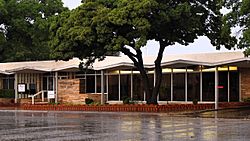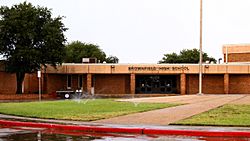Brownfield, Texas facts for kids
Quick facts for kids
Brownfield, Texas
|
|
|---|---|

Brownfield City Hall
|
|
| Country | United States |
| State | Texas |
| County | Terry |
| Area | |
| • Total | 6.55 sq mi (16.97 km2) |
| • Land | 6.51 sq mi (16.87 km2) |
| • Water | 0.04 sq mi (0.10 km2) |
| Elevation | 3,310 ft (1,009 m) |
| Population
(2020)
|
|
| • Total | 8,936 |
| • Density | 1,364.3/sq mi (526.58/km2) |
| Time zone | UTC−6 (Central (CST)) |
| • Summer (DST) | UTC−5 (CDT) |
| ZIP Code |
79316
|
| Area code(s) | 806 |
| FIPS code | 48-10720 |
| GNIS feature ID | 1352989 |
Brownfield is a city in and the county seat of Terry County, Texas, United States. Its population was 8,936 at the 2020 census. Brownfield is 39 miles (63 km) southwest of Lubbock.
Contents
History
In 1903, town promoters W. G. Hardin and A. F. Small purchased the county's central lot, platted the site, and named the town after the Brownfield ranching family. To boost chances of becoming the county seat, they granted a lot to every county voter.
The town's early years saw the construction of essential structures, including the courthouse, school, and churches. Hill's Hotel became the first business, housing the inaugural post office. On June 28, 1904, Brownfield secured the county seat designation, narrowly defeating Gomez in an election. The Brownfield State Bank opened in 1905, serving multiple counties and parts of eastern New Mexico.
Brownfield was incorporated in 1920. Oil wells became operational in 1941, diversifying the town's economic landscape.
Geography
According to the United States Census Bureau, Brownfield has an area of 6.3 sq mi (16 km2), 0.32% of which is covered by water.
Brownfield lies in the center of Terry County, in the southern portion of the South Plains and Llano Estacado. The city rests on a windblown deposit called the Blackwater Draw Formation, which is underlain by a thick layer of caliche, referred to locally as the "caprock". Beneath the caliche layer lies fluvial deposits called the Ogallala Formation, which contains a portion of the Ogallala Aquifer. The Caprock Escarpment, about 50 miles east, forms a precipitous drop of about 1,000 feet (305 m) and exposes various geologic layers. In early days, climbing the Caprock Escarpment was not easy for horse-drawn covered wagons.
The only terrain variation lies at the south end of the city, where Lost Draw carves a channel that runs across the entire county. Lost Draw formed over 10,000 years ago at the end of the last ice age, when the climate of the area was much wetter. When the vast glaciers of the north retreated, they left numerous dry river channels crisscrossing the Llano Estacado. When settlers during the 1800s ventured across this area, they often went into these channels expecting to find water, but unless significant rains had occurred recently, their search was in vain, with many of the parties becoming "lost", hence the name, Lost Draw.
The most notable geographic feature of Brownfield is its red soil. The soil creates an almost iridescent red color during sunrise and sunset due to the high iron oxide content.
Climate
Brownfield lies in a semiarid temperate zone, where high winds and extreme temperature variations are the norm. The summers reach over 100 °F (37.8 °C) for multiple consecutive days. The winters often fall below freezing for extended periods, but snow remains unusual due to very little precipitation forming in the winter.
The most significant time of the year for weather events starts in March and runs through September, when severe thunderstorms form on the Great Plains. Rain, winds, hail, and a few tornadoes are to be expected at this time of year. Late thunderstorms that produce hail are significantly harmful to the local economy, as it destroys the local cotton crop.
| Climate data for Brownfield, Texas (1991–2020 normals, extremes 1953–present) | |||||||||||||
|---|---|---|---|---|---|---|---|---|---|---|---|---|---|
| Month | Jan | Feb | Mar | Apr | May | Jun | Jul | Aug | Sep | Oct | Nov | Dec | Year |
| Record high °F (°C) | 84 (29) |
87 (31) |
97 (36) |
102 (39) |
110 (43) |
111 (44) |
109 (43) |
109 (43) |
104 (40) |
101 (38) |
88 (31) |
82 (28) |
111 (44) |
| Mean maximum °F (°C) | 75.0 (23.9) |
79.9 (26.6) |
86.8 (30.4) |
91.9 (33.3) |
98.8 (37.1) |
103.0 (39.4) |
101.8 (38.8) |
100.5 (38.1) |
97.4 (36.3) |
92.1 (33.4) |
82.7 (28.2) |
75.1 (23.9) |
105.0 (40.6) |
| Mean daily maximum °F (°C) | 55.1 (12.8) |
59.9 (15.5) |
68.2 (20.1) |
76.6 (24.8) |
84.5 (29.2) |
92.2 (33.4) |
93.6 (34.2) |
92.5 (33.6) |
85.2 (29.6) |
76.4 (24.7) |
64.3 (17.9) |
55.8 (13.2) |
75.4 (24.1) |
| Daily mean °F (°C) | 40.9 (4.9) |
44.8 (7.1) |
52.7 (11.5) |
60.6 (15.9) |
70.0 (21.1) |
78.3 (25.7) |
80.6 (27.0) |
79.3 (26.3) |
72.0 (22.2) |
61.8 (16.6) |
49.9 (9.9) |
41.9 (5.5) |
61.1 (16.2) |
| Mean daily minimum °F (°C) | 26.7 (−2.9) |
29.7 (−1.3) |
37.2 (2.9) |
44.6 (7.0) |
55.5 (13.1) |
64.5 (18.1) |
67.5 (19.7) |
66.1 (18.9) |
58.7 (14.8) |
47.3 (8.5) |
35.6 (2.0) |
28.0 (−2.2) |
46.8 (8.2) |
| Mean minimum °F (°C) | 14.7 (−9.6) |
17.1 (−8.3) |
22.0 (−5.6) |
31.1 (−0.5) |
41.6 (5.3) |
56.0 (13.3) |
61.7 (16.5) |
60.0 (15.6) |
47.0 (8.3) |
32.0 (0.0) |
21.1 (−6.1) |
14.9 (−9.5) |
10.7 (−11.8) |
| Record low °F (°C) | −8 (−22) |
−1 (−18) |
8 (−13) |
22 (−6) |
27 (−3) |
45 (7) |
53 (12) |
52 (11) |
36 (2) |
15 (−9) |
4 (−16) |
−1 (−18) |
−8 (−22) |
| Average precipitation inches (mm) | 0.69 (18) |
0.62 (16) |
1.07 (27) |
1.31 (33) |
2.20 (56) |
2.67 (68) |
1.94 (49) |
1.80 (46) |
2.56 (65) |
1.57 (40) |
0.88 (22) |
0.74 (19) |
18.05 (458) |
| Average snowfall inches (cm) | 1.4 (3.6) |
1.2 (3.0) |
0.3 (0.76) |
0.0 (0.0) |
0.0 (0.0) |
0.0 (0.0) |
0.0 (0.0) |
0.0 (0.0) |
0.0 (0.0) |
0.1 (0.25) |
0.8 (2.0) |
1.2 (3.0) |
5.0 (13) |
| Average precipitation days (≥ 0.01 in) | 3.4 | 3.3 | 3.8 | 3.5 | 5.7 | 6.5 | 5.2 | 5.7 | 6.2 | 5.2 | 3.7 | 3.3 | 55.5 |
| Average snowy days (≥ 0.1 in) | 1.0 | 1.0 | 0.2 | 0.1 | 0.0 | 0.0 | 0.0 | 0.0 | 0.0 | 0.1 | 0.5 | 0.8 | 3.7 |
| Source: NOAA | |||||||||||||
Economy
Cotton farming is the backbone of Brownfield. .....
A haze develops over the city as the local cotton gins go to work stripping the cotton from the burr, separating the seeds, and then compressing the cotton into 500-lb bales. The haze is actually fine cotton dust, and sometimes small drifts develop in the street resembling snow mixed with red soil.
Peanut growing has found a toehold on the economy, as have vineyards. In recent years, grape growing has made Terry County a producer of wine grapes used as filler for inexpensive wines. Several wineries are now established in the county, which produce average-to-poor quality wine according to numerous reviews and wine review aggregator websites. Local farmers, ranchers, and landowners began growing grapes here as early as 1950, with a few new wineries near the city due to the repeal of fully dry county status in 2008. Several older and more notable wineries are in the Lubbock area, about 30 miles northeast.
Oil production continues to drop from its previous levels in the 1980s. According to current trends, Terry County and Brownfield will continue to decline significantly in oil production and importance in West Texas.
Wal-Mart chose to not renew their lease on their facility on the eastern edge of town, saying the town was not sufficiently economically viable for them to continue to operate.
Demographics
| Historical population | |||
|---|---|---|---|
| Census | Pop. | %± | |
| 1930 | 1,907 | — | |
| 1940 | 4,009 | 110.2% | |
| 1950 | 6,161 | 53.7% | |
| 1960 | 10,286 | 67.0% | |
| 1970 | 9,647 | −6.2% | |
| 1980 | 10,387 | 7.7% | |
| 1990 | 9,560 | −8.0% | |
| 2000 | 9,488 | −0.8% | |
| 2010 | 9,657 | 1.8% | |
| 2020 | 8,936 | −7.5% | |
| U.S. Decennial Census 2020 | |||
Only 61.5% of the population holds a high school degree or higher, 8.9% a bachelor's degree or higher, and 2.7% a master's degree or higher. About 6.1% of the population was unemployed in 2010.
2020 census
| Race | Number | Percentage |
|---|---|---|
| White (NH) | 2,935 | 32.84% |
| Black or African American (NH) | 383 | 4.29% |
| Native American or Alaska Native (NH) | 25 | 0.28% |
| Asian (NH) | 36 | 0.4% |
| Some Other Race (NH) | 23 | 0.26% |
| Mixed/Multi-Racial (NH) | 137 | 1.53% |
| Hispanic or Latino | 5,397 | 60.4% |
| Total | 8,936 |
As of the 2020 United States census, there were 8,936 people, 3,271 households, and 2,086 families residing in the city.
Education
The City of Brownfield is served by the Brownfield Independent School District, ranked 899 out of 932 districts in Texas with a zero star rating. Brownfield ISD is considered a historically low-performing school district with abnormally high teacher turnover according to the local newspaper.
Brownfield High School was rated "academically unacceptable" by the Texas State Board of Education in 2011.
For the 2012–2013 school year, Brownfield High School State of Texas Assessments of Academic Readiness test scores resulted in the following student passing scores:
- 23% of students passed writing
- 45% of students passed algebra
- 67% of students passed biology
- 54% of students passed chemistry
- 48% of students passed reading
- 19% of students passed geography
For the 2021–2022 school year, Brownfield High School was ranked among the bottom 15% of all high schools in Texas, with a ranking of 1414 out of 1861 high schools.
Transportation
Brownfield, situated at the crossroads of U.S. highways 62, 82, 380, and 385, as well as Texas State Highway 137.
Dry county status
Several town meetings were held in 2008 to discuss the issue of selling beer and wine in Terry County. On November 4, a majority of registered voters voted to legalize the sale of beer and wine in Terry County (1533 for, 1211 against).
See also
 In Spanish: Brownfield (Texas) para niños
In Spanish: Brownfield (Texas) para niños


